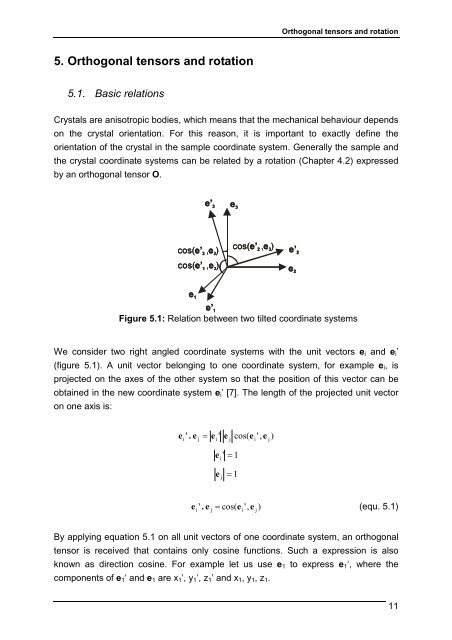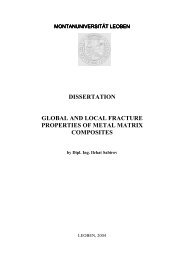Diploma Thesis - Erich Schmid Institute
Diploma Thesis - Erich Schmid Institute
Diploma Thesis - Erich Schmid Institute
You also want an ePaper? Increase the reach of your titles
YUMPU automatically turns print PDFs into web optimized ePapers that Google loves.
5. Orthogonal tensors and rotation<br />
5.1. Basic relations<br />
Orthogonal tensors and rotation<br />
Crystals are anisotropic bodies, which means that the mechanical behaviour depends<br />
on the crystal orientation. For this reason, it is important to exactly define the<br />
orientation of the crystal in the sample coordinate system. Generally the sample and<br />
the crystal coordinate systems can be related by a rotation (Chapter 4.2) expressed<br />
by an orthogonal tensor O.<br />
We consider two right angled coordinate systems with the unit vectors ei and ei’<br />
(figure 5.1). A unit vector belonging to one coordinate system, for example ei, is<br />
projected on the axes of the other system so that the position of this vector can be<br />
obtained in the new coordinate system ei’ [7]. The length of the projected unit vector<br />
on one axis is:<br />
Figure 5.1: Relation between two tilted coordinate systems<br />
e i ' . e j = ei<br />
' e j cos( ei<br />
',<br />
e j)<br />
e i ' = 1<br />
j 1 = e<br />
e . e = cos( e ',<br />
e )<br />
(equ. 5.1)<br />
i ' j<br />
i j<br />
By applying equation 5.1 on all unit vectors of one coordinate system, an orthogonal<br />
tensor is received that contains only cosine functions. Such a expression is also<br />
known as direction cosine. For example let us use e1 to express e1‘, where the<br />
components of e1‘ and e1 are x1’, y1’, z1’ and x1, y1, z1.<br />
11

















